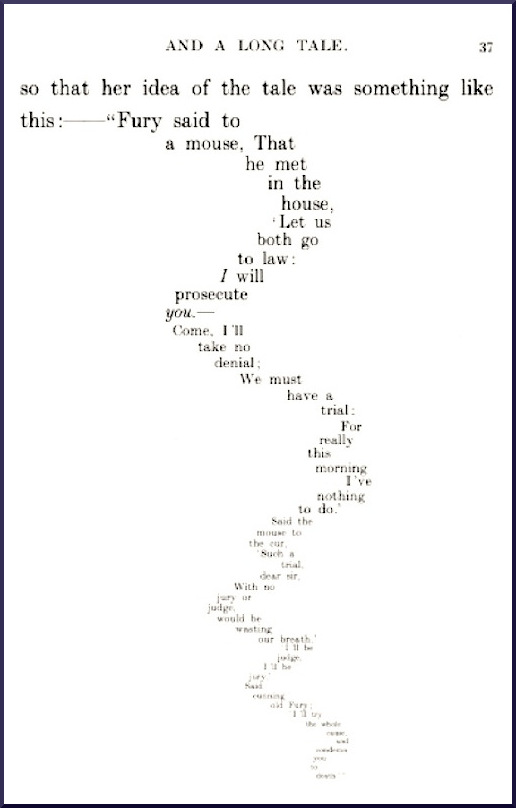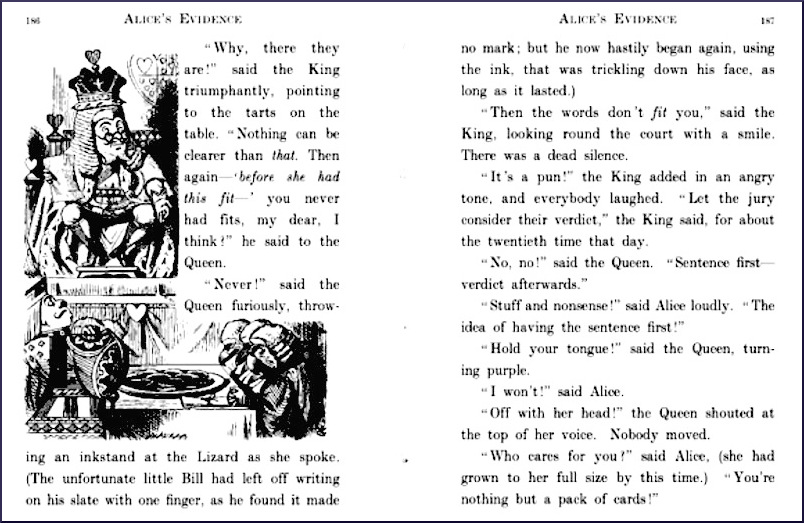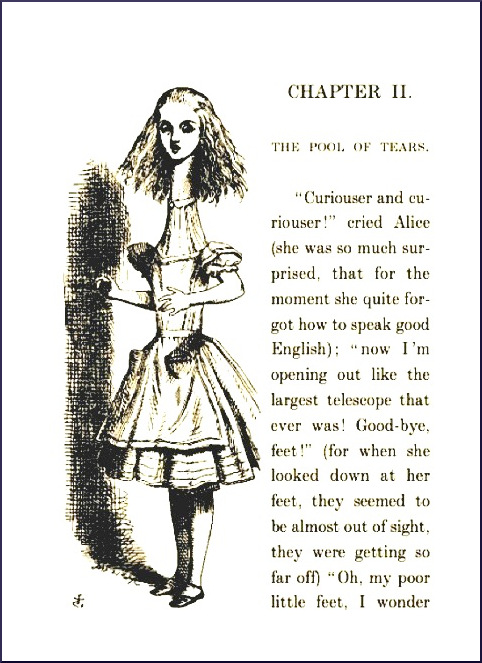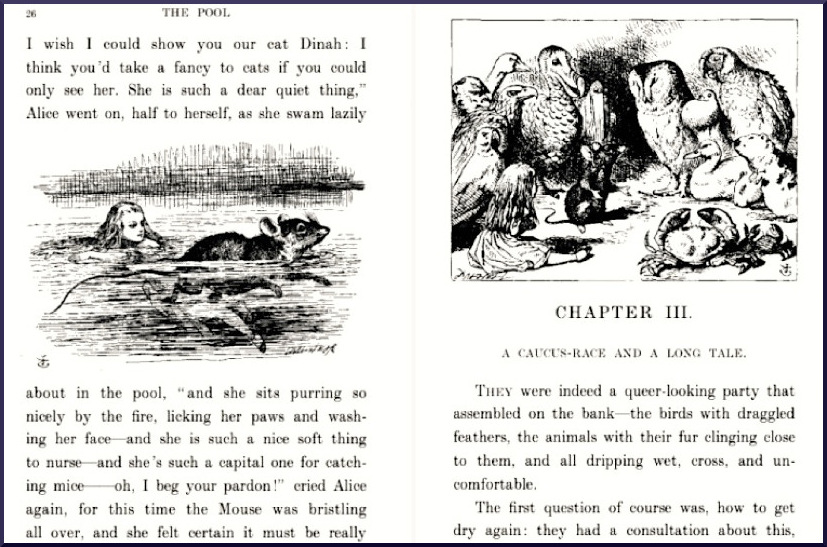The author has kindly shared with us this recent post from her blog, The Cabinet of Curiosity. It has been reformatted for our website, with her own selection of images. Click on the smaller images to enlarge them. — Jacqueline Banerjee

At the start of Alice's Adventures in Wonderland Alice's very first thought – "What is the use of a book, without pictures or conversation?" — places the visual and verbal interplay at work in Carroll's books under the magnifying glass. It is as though this declarative desire for pictures spirits Alice away to Wonderland. Her imaginative dreaming creates the phantasmagorical images her sister's book lacks.

As Helen Groth notes, the visual mediation of John Tenniel's illustrations creates "a more porous surface between Alice and her readers; an intimate synchronous connection" that dynamically urges the reader forward. Tenniel's illustrations are to be found at the metaphorical and literal centre of Carroll's text. The narrator continually points readers towards them ("if you don't know what a Gryphon is, look at the picture" [138].) He even ensures that Alice's imagined "tale" of the mouse's "tail" is structured so that the "tail rhyme" of the poem resembles a long tail.
The Nursery Alice, published for children aged "nought to five" at the zenith of Alice's popularity, takes this visual focus further. The book houses enlarged coloured pictures that dwarf the text and allow Carroll to create tangential stories retrospectively inspired by Tenniel's illustrations. Tenniel's drawing of a foxglove, for example, inspires a quasi-etymological tale in which Carroll informs us "Foxgloves are the gloves of Fairy Folk."
Furthermore, the narrator continually urges the reader to manipulate the illustrations so as to better understand the story. He encourages them to "shake the book and you'll see [the rabbit] tremble" and "turn up the corner of this leaf, [and] you'll have Alice looking at the Grin: and she doesn't look a bit more frightened than when she was looking at the Cat, does she?" Carroll similarly urges the buyers of his postage stamp cases to "take the Case ... you see Alice nursing the Duchess's Baby? Pull it out – the Baby has turned into a Pig!" These transformative uses of Tenniel's illustrations celebrate visual-verbal interplay and suggest that pictures can aid a child's inchoate understanding of the verbal text.

"The Wonderland Postage-Stamp Case" (see bibliography), with thanks to the British Postal Museum and Archive; designed by Lewis Carroll.
In "Wonderland" the visual often threatens to dwarf the textual. Just as with one bite of the mushroom Alice oscillates between microscopic and gigantic, with one turn of the page the reader may find the text dwarfed by Tenniel's rapidly "mushrooming" illustrations. Thus, though the term "illustrate" originally meant to "illuminate the mind" the felicitous placement of illustrations in the first edition of Alice suggests that the drawings are not merely secondary elucidations, instead, they are inextricable from the text itself. Carroll's words often not only refer to the illustrations but are reliant upon them.

For example, the courtroom scene on page 186 curiously omits the Queen in order to fit into Carroll's text. This allows for an episode of visual-verbal wordplay in which the pun "then the words don't fit you" (187) refers to the Queen's pictorial lacuna and seems to be spoken by the pictorial rather than the textual King. It is for this reason that the "textual" court greet his pun with "dead silence" (187) as they cannot understand a joke that relies on the consciousness of their pictorial counterparts.

Throughout the novel, the symbiotic relationship between visual and verbal continues to rely on the novel's composition. When Alice's body elongates, the body of text mirrors her elongation. As Alice feels she is "opening out like the largest telescope that ever was!" (15), her neck resembles the cylinder of a telescope extended from her compact body. The psychosomatic dissonance Alice experiences (she worries her feet won't obey her unless she sends them new boots for Christmas) is reflected in the illustration. Tenniel details her wide eyes, open mouth and fanned out hair (which suggests a sudden altitude change), and her arms splayed out as if to slow her body whilst falling.
Later in the novel, Alice looks titanic in relation to the Rabbit, the hallway, and the page itself. Tenniel uses foreshortening – converging ceiling panels and highlighting Alice in the foreground whilst darkening the receding hallway. This creates a linear perspective that gives the illusion of depth and produces a rabbit-hole for the startled rabbit to retreat into. Tenniel's imposing illustration creates a paradoxical disparity between text and image. After scolding herself for crying ("you ought to be ashamed of yourself ... a great girl like you!") Alice tentatively addresses the rabbit "in a low, timid voice" that quite belies her gargantuan size. Her hesitant posture suggests an answering recoil when the rabbit greets her not as a little girl but as a predator: scurrying away "into the darkness as hard as he could go" (18).
Lewis Carroll appears decidedly satisfied with Tenniel's rendering of scale; according to a subsequent illustrator, Carroll would "take a square inch of the drawing, count the lines ... and compare their number with those on a square inch of illustration made for Alice by Tenniel! And in due course [he] would receive a long essay on the subject from Dodgson the mathematician" (Furniss 78). This emphasis on dimension and mathematical topography suggests that Carroll informed Tenniel in detail of the importance of depicting Alice's oscillating growth.

Carroll himself used space and dimension to its full semantic capacity. In his illustration of the same scene, Alice's overgrown form is wrapped in a protective foetal position. But she is confined not by the Rabbit's house but by the confines of her frame – functioning as an amateur "Trompe-l'oeil," Carroll's illusion of protuberance possesses a distinctly claustrophobic quality.
Contrastingly, Tenniel offers a near three-dimensional imprisonment: Alice's elbow is painfully positioned in the corner of the room; her head bowed, and her arm forced through the window. The intense use of chiaroscuro combined with Alice's reproachful expression presents an image reminiscent of a caged animal. This pictorial suggestion ties in with Alice's anxiety regarding her fluctuating size, which is viscerally linked with conceptions of predation: "It was much pleasanter at home when one wasn't always growing larger and smaller, and being ordered about by mice and rabbits. I almost wish I hadn't gone down that rabbit-hole" (46). In this context "the rabbit-hole" becomes an evolutionary abyss in which Alice can both regress into a creature of embryonic size and metamorphose into a being at the top of the food chain.

Tenniel and Carroll inextricably link Alice's relative size with her survival. Tenniel's illustration for page twenty-six depicts Alice nonchalantly swimming alongside a mouse. This evidently takes place after she fears he is a "walrus" or "hippopotamus" and instead remembers her own size and haughtily deduces it is "only a mouse." Alice goes on to regale the mouse sadistically with tales of her cat. Even after she answers his cry "would you like cats if you were me?" with the reluctant avowal "perhaps not," she insensitively urges him not to "be angry about it" and boasts that Dinah is "a capital one for catching mice" (26) Tenniel's drawing (bisecting Alice's lyrical waxing) focuses on the divergent paths of the two figures: Alice regards the mouse with a vague sort of interest, her relaxed legs below the water propel her lazily in one direction, whilst the mouse's taut legs frenetically drive his anxious straining form in the decidedly opposite direction. The illustrations and text work in tandem to imply what might happen if a mouse-sized Alice were to meet Dinah.
In "Alice in Wonderland: The Child as Swain" William Empson argues that "the pool of tears represents both the primeval sea from which life arose and amniotic fluid; the caucus-race which follows refers to the theory of natural selection; [and] the ape which appears in the illustrations is man's simian ancestor" (255). This reading is supported by Tenniel's illustration, which portrays Alice as an irrevocable member of the homogenous "queer-looking party": her hair heavy with water is akin to the sodden feathers and fur of the other animals. The animals themselves are drawn with scientific accuracy and have been likened to contemporary taxonomy drawings.
Similarly, in her discussion on Darwinian narrative Gillian Beer asserts that "because of its preoccupation with time and with change, evolutionary theory has inherent affinities with the problems and processes of narrative" (6) — Alice in Wonderland is a novel that both textually and pictorially manifests these evolutionary fluctuations. Carroll's disordered narrative, condemned in a contemporary review in the Athenaeum as all "loops and ties, and loose threads, and entanglements, and inconsistencies" (844) and Tenniel's taxonomic, dimensionally inversive illustrations, combine to produce a united text that, in carnivalesque protest, ousts Alice from her evolutionary position.
A new edition of Alice illustrated by Arthur Rackham is prefaced by the verse:
Enchanting Alice! Black-and-white
Has made your deeds perennial;
And naught save "Chaos and old Night"
Can part you now from Tenniel
Although this verse seems to suggest that Alice is immortalised in Tenniel's drawings, a later verse —
But still you are a Type, and based
In Truth, like Lear and Hamlet;
And Types may be re-draped to taste
In cloth-of-gold or camlet
— suggests that Alice can, like a new actress in a play, be "re-draped" to new taste. However, I would argue that "afresh Costumier" cannot imbibe his drawings with the same hermeneutic potential as Tenniel. Not only do the illustrations contain infamous details to the story that are not born from the text (the March-Hare's hat of straw or the Hatter's 10/6 price tag, for example) they are also visually synchronised with the narrative. Therefore, Tenniel's work does not simply mirror Carroll's narrative; instead it provides a kaleidoscopic reflection that like Carroll's own looking-glass curiously transmutes the original.
Related Material
- The Textual Alice and the Alice of Illustration (for a different point of view)
- The Tenniel Gallery (1)
Bibliography
"Alice's Adventures in Wonderland." Athenaeum. No. 1990. 16 December 1865.
Beer, Gillian. Darwin's Plots. Cambridge University Press, 2000.
Carroll, Lewis. Alice's Adventures in Wonderland. BookVirtual, 2000.
_____. Alice's Adventures in Wonderland, with a poem by Austin Dobson. Illus. Arthur Rackham. London: Doubleday, 1905.
_____. The Nursery Alice. London: Macmillan, 2010.
Empson, William. "Alice in Wonderland: The Child as Swain." Some Versions of Pastoral. London: Chatto and Windus, 1935.
Furniss, Harry. Some Victorian Men. London: John Lane, 1924.
Groth, Helen. "Projections of Alice: anachronistic reading and the temporality of mediation." Textual Practice. 26.4 (2012): 667-686.
The Wonderland Postage Stamp Case. British Postal Museum and Archive. Web. 13 May 2016.
Created 13 May 2016